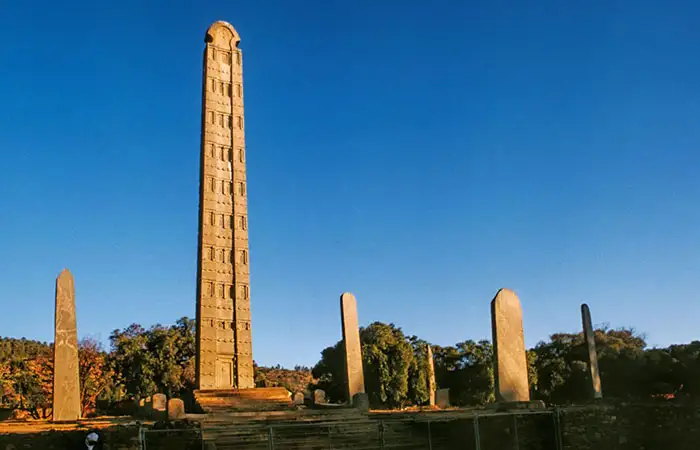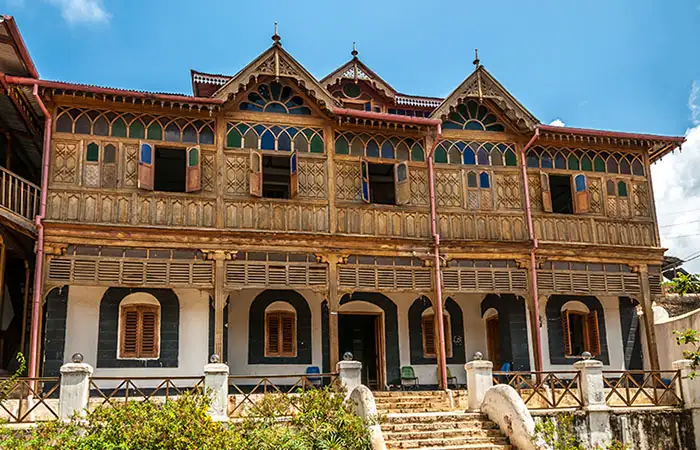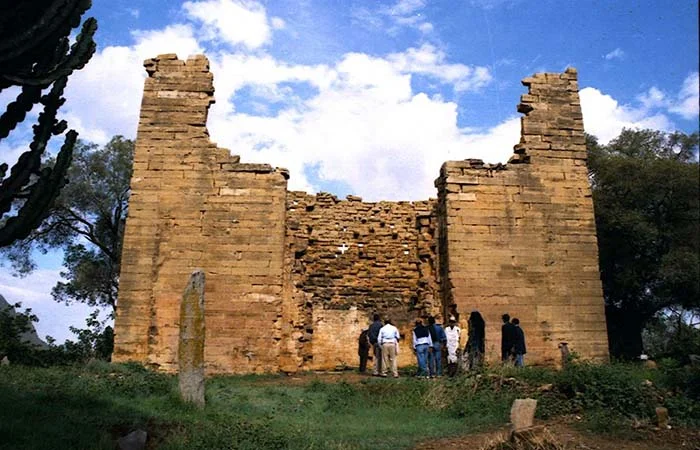Historical Attractions

Axum
The ruins of the ancient city of Aksum are found close to Ethiopia’s northern border. They mark the location of the heart of ancient Ethiopia, when the Kingdom of Aksum was the most powerful state between the Eastern Roman Empire and Persia. The massive ruins, dating from between the 1st and the 13th century A.D., include monolithic obelisks, giant stelae, royal tombs and the ruins of ancient castles. Long after its political decline in the 10th century, Ethiopian emperors continued to be crowned in Aksum. It is ornamented with two false doors at the base and features decorations resembling windows on all sides. The obelisk ends in a semi-circular top part, which used to be enclosed by metal frames. The stelae were probably carved and erected during the 4th century AD by subjects of the Kingdom of Axum.

Lalibela
Lalibela is a town in the Amhara region of northern Ethiopia. It’s known for its distinctive rock-cut churches dating from the 12th and 13th centuries, which are pilgrimage sites for Coptic Christians. Carved out of rock, the subterranean monoliths include huge Bete Medhane Alem, and cross-shaped Bete Giyorgis. Many are joined by tunnels and trenches, and some have carved bas-reliefs and colored frescoes inside. The Church of St. George is one of eleven rock-hewn churches of Lalibela. This is an independent structure , which is attached to the rock by the base. Built on a cruciform plan ( Greek cross ) 25 meters wide , it is 30 meters high and it is fully excavated in the tray consists of a red volcanic rock and connected by a series of tunnels to the group of four churches located in the Northeast.

Harar
Harar is the capital city of the Harari Region. The ancient city is located on a hilltop in the eastern part of the country and is about 500 kilometres (310 mi) from the Ethiopian capital Addis Ababa at an elevation of 1,885 metres (6,184 ft). For centuries, Harar has been a major commercial center, linked by the trade routes with the rest of Ethiopia, the entire Horn of Africa, the Arabian Peninsula, Asia, and through its ports, the outside world. Harar Jugol, the old walled city, was listed as a World Heritage Site in 2006 by UNESCO in recognition of its cultural heritage. Because of Harar’s long history of involvement during times of trade in the Arabian Peninsula, the Government of Ethiopia has made it a criminal offence to demolish or interfere with any historical sites or fixtures in the city. These include stone homes, museums and items discarded from war. According to UNESCO, it is “considered ‘the fourth holiest city’ of Islam” with 82 mosques, three of which date from the 10th century, and 102 shrines.

Gonder
From kings and churches to emperors and castles: another not-to-be-missed stop on Ethiopia’s Historic Route is what has been called the ‘Camelot’ of Africa: Gondar
Gondar is a Royal and ancient historical city of Ethiopia. It is the home of many Emperors and Princess who lead the country from the 12th century to the last decade of the 20th century.It is the home of the highest mountain in Ethiopia, Ras Dashen, and the Simien Mountains National Park.
Nestled in the foothills of the Simien Mountains in north¬western Ethiopia, Gondar became the capital during the reign of Emperor Fasilidas (1632-1667), who built the first of a number of castle-like palaces to be found here. He established a tradition that was followed by most of his successors, whose buildings greatly enhanced the city’s grandeur. In its day, the city was an important administrative, commercial, religious, and cultural centre. It was famous for its sophisticated aristocratic life, its church scholarship, and its extensive trade, which took its merchants to Sudan and the port of Massawa as well as to the rich lands south of the Blue Nile. Gondar was also noted for the skill of its many craftsmen. The city retained its pre-eminence until the middle of the nineteenth century, when Emperor Tewodros II moved his seat of Government to Debre Tabor and later to Mekdela. As a result, Gondar declined greatly in importance and was subsequently looted in the 1880s by the Sudanese Dervishes. By the early nineteenth century the city was a mere shadow of its former self. More recently, its appearance was not aided by the fact that several historic buildings were damaged by British bombs during Ethio¬pia’s liberation campaign of 1941. Most of Gondar’s famous castles and other imperial buildings nevertheless survived the ravages of time: and together constitute one of Ethiopia’s most fascinating antiquities.

Yeha temple, temple of the Moon
Discovered in the town of Yeha in the Mehakelegnaw Zone of the northern Tigray region, the stone tower is built in a Sabean-style, common across much of sub-saharan Africa. Towering over the small town, which is considered by many to be the pre-aksumite capital of the country, the temple of the moon was built in honour of the god Almougah, and dates back to around 700 BC to the reign of D’mt.
Stone carved inscriptions found across the site detail grand tales of Almougah’s glory and their power to cast out the harsh unrelenting sun. Despite its now dilapidated facade, a sense of awe still overcomes those who wander past the five-metre tall doorway, into a cavernous space with a deep pool in the middle, which was used for ceremonial and sacrificial purposes. All the limestone used in its construction was sourced from a local quarry, only 90 miles away from the site, and was built without the use of cement or mortar making its longevity even more puzzling.
As Christianity spread across the land, the site was adopted by early followers and converted into the monastery St Abuna Aftse, which remains to this day. Various archaeological digs have been conducted around the area, many of which are still ongoing, uncovering millennia worth of history. Hidden beneath the shifting sands that surround the site as new layers are unearthed, Yeha temple and her long illustrious history is slowly being revealed.
